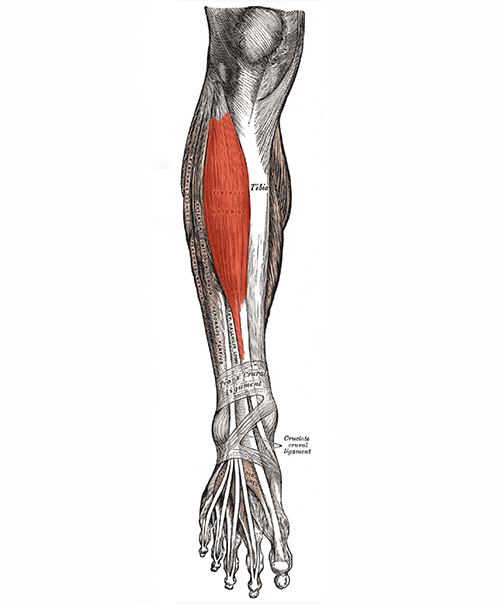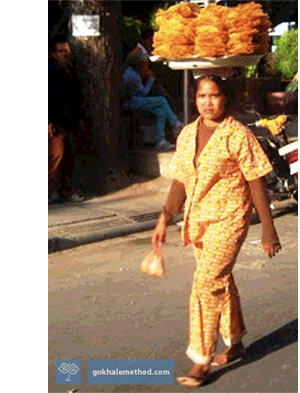Welcome to the fourth blog post in our series on running. My name is Michelle Ball, and I am a Gokhale Method® teacher living in Tasmania. I am also a lifelong runner and am passionate about sharing the benefits of healthy posture with the running community, be that beginners, seasoned runners, or anyone in between. Even if you don’t run, but do want happy, pain-free knees well into old age, this blog post is for you!
Common knee injuries and pathologies
As hinge joints situated in the middle of long, weight-bearing limbs, knees can be vulnerable to injuries. Let’s take a look at some common runner’s knee problems, and their solutions.
Ligament tears may result from twists, or the sudden changes of direction that are common in soccer or basketball—or from an awkward landing while running.
This illustration shows the bones, main muscles, meniscus, and ligaments of the knee. Wikimedia
Runner’s knee, or patellofemoral pain syndrome (PFPS), is probably the most common runner’s complaint and is a knee pain associated with the patella or kneecap. It’s thought to be caused by an imbalance in the muscles that support your knee, and mechanical errors that can cause poor knee tracking.
Other common causes of pain and loss of normal knee function are injuries to the meniscus—the “shock absorbers” within the knee joint. While sudden trauma can cause meniscus tears, these tears often become more prevalent due to wear and degeneration in the knee joint over the years. This is especially likely if people carry considerable extra weight or stress the joint repeatedly in sport.

The twists, turns and impacts of sports such as soccer and football can be hard on the knees. Healthy posture in daily life brings good body alignment and helps build the resilience needed on the field. Pixabay
Happy knees depend on happy feet and ankles
From a Gokhale Method perspective, while there is always some risk of accidents in sports and activity, our observations tell us that the likelihood of significant injury, and “everyday” wear and tear, is substantially reduced where there is healthy posture. The improved biomechanics that healthy posture bestows also means that if you are unfortunate enough to hurt yourself, you are much more likely to recover well.
In Running: Part 2 and Running: Part 3 we looked at how our feet and shoes can play their part in setting us up for optimal alignment, with the feet and ankles positioned to make a healthy foundation for the tibial bones and knees. You may want to check out these posts if you missed them.
External rotation of the legs is a game-changer
One of the biggest improvements that the Gokhale Method made to my running came from learning to externally rotate my legs. This reduces any tendency towards knock-knees, an internal rotation of the leg which puts a lot of pressure on the inner knee.
Kidney-bean shaping the feet is key to achieving external rotation, as described in Running: Part 2, as is the lower leg muscle to help support the knee in this alignment, the tibialis anterior, or “shin-splint muscle." As its name suggests, it also functions to prevent undue stress on the shin bone due to high impact. You may otherwise experience sharp pain along the inside edge of the shin due to inflammation, and even stress fractures.

Tibialis anterior starts from the outer edge of the tibia and crosses the shin and ankle, becoming a long tendon which inserts on the underside of the foot arch behind the big toe. Wikimedia
One effective exercise for strengthening the tibialis anterior is the “toe tap," which I really enjoy teaching my students. This very specific exercise is taught in both our beginner’s courses for learning the Gokhale Method—the in-person Foundations course and online Elements course. Directions can also be found in Esther Gokhale’s best-selling book, 8 Steps to a Pain-Free Back.
Esther Gokhale demonstrates the toe tap exercise for tibialis anterior.
This is one of many free
Gokhale Moment videos.
No more tripping over your own feet!
As you can see in the video, tibialis anterior is the muscle that lifts the front of your foot clear of the ground. So if you have a problem with tripping, either over your own feet or over every root or wonky sidewalk, this exercise is for you. It will also make your running safer.
Its long tendon enables the tibialis anterior muscle to lift the front of the foot away from the ground. Wikimedia
Knees need a warm-up
Some things in life can turn full on at the flick of a switch—others need to warm up gradually. Knees are definitely in the latter category. Unless you have already been active in your day, (e.g. walking up hills, gardening), I advise a warmup of brisk walking, building to a jogging pace. Research now indicates that static stretching prior to exercise such as running actually impairs muscle performance¹, while gently increasing the intensity of movement primes and dynamically stretches many of the muscles you use to run. In addition, incrementally ramping up from walking brings synovial joint mobility, prepares the cardiovascular system, and allows muscles to oxygenate.
Softer landings, both walking and running
Some people land with a straightened front leg when they walk, which is jarring and potentially damaging for the knees. If you suspect you have this habit, take a few seconds of video of yourself walking (side on) and play it back in slo-mo to check. You want to be landing with a slightly bent front knee.


In traditional communities people often walk for many miles a day, frequently carrying heavy loads. With healthy posture intact, they do so without developing knee problems. Here you see a woman in Cambodia, and a man in India.
This natural phase of the human gait softens the impact on your knee joint as your foot contacts the ground and helps ensure your knees are in good condition for running. If you find you are habitually landing on a straight front leg, consider an Initial Consultation, online or in person, with a Gokhale Method Teacher, who can analyze your walking and suggest ways forward. This is definitely a case of learning to walk before you run!

Here you can see me running, about to land midfoot with a bent front knee.
Many runners find that changing to more of a midfoot landing rather than a “heel strike” landing is gentler on the knees. While landing on the heel bone is a healthy part of good walking form, in running the additional forces can be absorbed better through the mid foot (possibly after a fleeting contact with the heel) and then be used to aid propulsion. Adopting a midfoot landing has certainly enabled me to run more smoothly.
This slo-mo video captures how a bent front knee with a midfoot landing absorbs the force of impact and cushions my joints.
With the foot and ankle below, and the hip above, the knee joint is inescapably “piggy in the middle." The knee depends on healthy foot and ankle alignments at one end, and at the other on a well-positioned pelvis, strong gluteal muscles, and healthy hips. Together with a bent front knee they can deliver the foot to the ground in a controlled way, well aligned and without jarring or excessive impact. We will look at the contribution of healthy posture in the hips and pelvis in my next running post.
References:
¹Warren B Young et al., “Should Static Stretching Be Used During a Warm-Up for Strength and Power Activities?," Strength and Conditioning Journal 24, no. 6 (Dec. 2002): 33–37,
https://doi.org/10.1519/00126548-200212000-00006.
If you would like to find out more about how the Gokhale Method can help support you, sign up to join one of our upcoming FREE Online Workshops.



Comments
Yes, when it comes to running
Yes, when it comes to running, the feet are sometimes the unsung superstars. It's amazing to see how our contemporary way of life, with its emphasis on smooth, featureless surfaces, has affected the way our feet naturally develop and become strong. There is a noticeable difference between walking on naturally uneven terrain and the frequently flat basket random, unforgiving surfaces we experience on a daily basis.
As you pointed out, shoes are quite important. It's intriguing to think about the potential role that specific shoe styles may have in our feet's passive condition. A closer examination of the decisions we make in the name of comfort and performance is prompted by the notion that even certain running shoes may qualify as less-than-ideal footwear.
People bet on sports more and
People bet on sports more and more, and now you can officially bet on any team or sport. I bet on cricket, football, and other games. Check cricketbook is where I do my betting. Some people will always win and some will always lose, but not me anymore